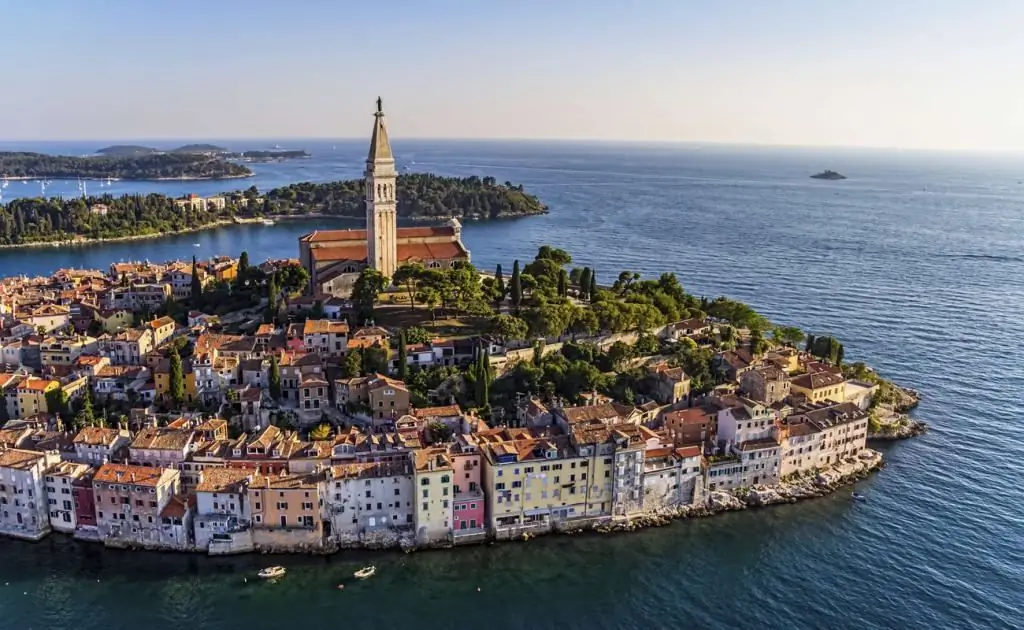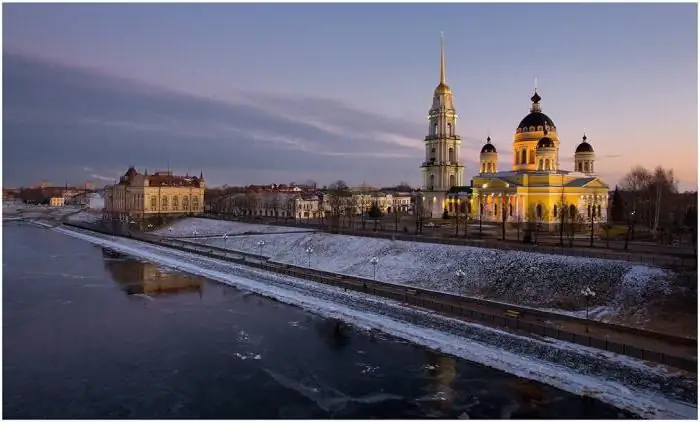- Author Harold Hamphrey [email protected].
- Public 2023-12-17 10:06.
- Last modified 2025-01-24 11:10.
Moscow Region is a vast territory where a fairly large number of historical and cultural monuments of noble estate life have been preserved to our time. Among the most interesting estates is the Schapovo Estate Museum.
Schapovsky estate and its name
The history of local lands is connected not only with the Shchapovo estate, but also with a small village, which is mentioned in the cadastres of the early 17th century. as the property of the boyar V. P. Morozov. Then it was called Alexander. Later found under the name "Alexandrovo". The exact origin of the name is unknown, but it can be assumed that it was given by the name of a noble person who founded the settlement. It cannot be called by the name of Morozov's daughter, which was given as a wedding gift, since her name was Maria.
The history of the Shchapovo estate begins with the Morozovs. The next owners of the estate were Maria Vasilievna Morozova and her husbandA. V. Golitsyn. And after the death of the latter, the estate again returned to the possessions of the Morozovs, and at the end of the 17th century. - into the royal possession due to the absence of Morozov's heirs.
The modern layout of the estate dates back to the time of its ownership by the Grushetsky brothers - at the end of the 18th century. It was Vasily Vladimirovich Grushetsky who made big changes to the appearance of the estate: he replaced the old wooden church of the Assumption with a stone one, built a system of ponds on the backyard territory, planted a linden park.

After the Grushetskys, the Shchapov brothers owned the estate, hence the second name of the estate. Now it is known as Aleksandrovo-Shchapovo. I. V. Shchapov built a stone two-story house and a stone kitchen in it, equipping it with a cellar, the master's stable, a spacious glacier, a carriage house, a forge, a decoratively decorated dairy building, greenhouses and a barnyard. On the Shchapov farm, they produced their own dairy and sour-milk products, bred cattle, grew vegetables and fruits. A lace-making school, an agricultural school, and a parochial school were opened.

During the post-revolutionary changes, the manor passed a rather happy path: all the buildings and schools were preserved in it, and a kindergarten was located in the master's house. Over time, an agricultural technical school was opened here, and later - an educational facility of the Timiryazev Agricultural Academy.
Aleksandrovo was renamed Shchapovo in order to preserve the memory of a man whose life was aimed at improving the life of the peasants. Shchapov was also named a modern settlement that arose here in Soviet times.
Manor owners
Boyarin Vasily Petrovich Morozov was a representative of an old Moscow family. His service under the royal throne was quite successful. Initially, he served in the military under Tsar Fyodor Ivanovich and participated in the Rugodiv campaign with the rank of Yesaul. Then he served alternately as governor in Tula and Pskov. And under Boris Godunov he received the rank of roundabout. During the years of the Polish intervention, he did not go over to the side of False Dmitry and remained loyal to the Fatherland and the Tsar. He received the boyars during the short reign of Vasily Shuisky for his participation in the suppression of the Bolotnikov uprising. He was appointed governor in Kazan. During the Polish-Lithuanian intervention, he fought as part of the First and Second Home Guards. He was a member of the government and the Zemsky Sobor under Mikhail Fedorovich Romanov, and also briefly headed the Judgment Order.
Andrey Vasilyevich Golitsyn was also a representative of an old Moscow noble family. He also fought in the rank of Yesaul under Boris Godunov. He especially distinguished himself in the campaign against Khan Kazy-Girey Bora. Participated in the suppression of the Bolotnikov uprising and in the fighting during the Polish-Lithuanian intervention. But he betrayed the Fatherland, joining the government that supported the enthronement of the son of the Polish king, and was executed.
Ivan Vasilyevich Morozov, brother of Maria, was a very famous person at the Romanov court, "led" among the boyars. His name is mentioned in connection with B. Khmelnitsky's application for Russian citizenship.
Boris Ivanovich Morozov served underthe royal court by the tutor of Alexei Mikhailovich Romanov himself. Perhaps he also served as a regent for the young king.
Vasily Vladimirovich Grushetsky was a representative of the Lithuanian noble family. In Russia, he served as a senator and had the rank of real state councilor. Part of his life was also connected with a military career: a holder of orders, a lieutenant general, he participated in the Russian-Turkish war and the annexation of Crimea to Russia.
Ilya Vasilyevich Shchapov is one of the largest Moscow industrialists, who organized his production and the life of workers at the advanced European level. Having received the estate, he retired, leaving his brother with them, and he retired to Shchapovo, where until the end of his days he introduced the latest ideas to improve personal and peasant life.
Church Primary School
The purpose of the opening of schools in his new estate by the former industrialist I. V. Shchapov was the elimination of total illiteracy among his peasants. This school was for boys only. In Podolsk, to which Alexandrovo was also subordinate, at that time there was a branch of the brotherhood of the Moscow Cyril and Methodius Monastery. It was it that supplied Shchapov's school with textbooks, teachers, and equipment. In return, the owner of the estate had to provide a building for the school, which Ilya Vasilyevich erected. Pupils were provided with Schapov food, maintenance, clothing. Houses for teachers were also erected nearby.
In Soviet times, the school became a four-year elementary "first stage", later it was retrained into a seven-year school and graduallyhas become standard, where training lasts 11 years.
School of lacemakers
It was intended for the vocational training of peasant girls. Originally housed in a large peasant hut. At the beginning of the 20th century By decision of the Zemstvo, a special building was built for the school. The students wove thread lace with the help of bobbins. Such a craft provided them during the unemployed autumn-winter season. The girls were taught literacy, arithmetic and the Law of God.
The school was closed in 1919, because under the new government, lace was considered a relic of the past, bourgeois habits. The Communist Youth Club was organized in the building. And in 1920, by decision of the government, classes were to be resumed again. However, the school was not restored, and over time, due to the death of lacemakers, this task became completely impossible.
Agricultural school
The agricultural school was created after the death of the philanthropist using the funds left by him, and the building for it was also built - according to the project of K. V. Tersky. It is built of red brick and has two floors. Support in the construction was personally provided by Grand Duke Sergei Alexandrovich.

There were eight classrooms in the school building, some of them were used as bedrooms out of necessity. Boys received two educations here at once: secondary and vocational.
Architecture of the manor house
In the estate of Shchapovo-Aleksandrovo, the master's house built in the late 18th century is well preserved. It is made of stonean extension of the second floor made of wood, decorated with carved decor in the traditions of ancient Russian architecture. The turret on the second floor above the staircase inside has wall and ceiling paintings made in antique scenes.

The Shchapovs lived in this house. The house is connected to the glacier and the kitchen. During excavations nearby, the foundations of an old house, apparently Grushetsky, were also discovered, but the building itself is not subject to reconstruction at this time.
The current state of the estate
At present, judging by the reviews, the estate of Shchapovo, Podolsky district, is in a completely intact state. Here you can stroll through the linden park, see the system of ponds and the stream, the bottom of which is carefully lined with white stone by the manor gardener. You can visit the museum of the estate, and in the building of the former school, listen to organ music in the concert hall. You can visit the Church of the Assumption of the Blessed Virgin Mary, see the glacier, the building of the former agricultural school, the stable, the kitchen, the manager's house and the master's house.

Unfortunately, at the moment the kitchen is in a mothballed state, because after placing a grocery store here, it has become more like a box without a roof. And the building of the manor's house was put on the waiting list for restoration in connection with the possible loss of parts of the facade, which began to collapse after the outpatient clinic left here. But surprisingly: in front of the house, a section of the pavement, laid out under the owner of the estate from white stone, has been preserved.
The road to the village and the estate is located between Kaluga and Warsaw highwaysand is in fair condition.
Church of the Assumption
The church of the estate was consecrated before Shchapov in the name of the Assumption of the Blessed Virgin Mary. It was later rebuilt in stone. It has a relatively small size and a three-part "ship" shape: a temple-chapel, a refectory and a belfry.

The main volume of the temple has a rectangular shape and more resembles an ordinary residential building without additional outbuildings. Has two floors. The walls are cut by two tiers of rectangular windows. The entrance to the building is not in the west, as it should be according to the canons, but in the south. Decor not used. On the east side, a small semicircular apse is attached to the main volume. It is one story high.
In the church, only one icon has been preserved since Shchapov's time - the "Holy Trinity". She was forgotten here when they took out other utensils and property, as they put it under the wheels of the car so that it would not skid in the mud. The trace on the icon has been preserved.
Museum Collection
The history of the Shchapovo estate museum, founded in 1998, is associated with the name of one of Shchapov's descendants, Yaroslav Nikolaevich. He served as director here for a long time.

The museum collection contains authentic items of the owners of the estate, expositions dedicated to the war of 1812, the history of the village and the family of the owners, exhibits telling about the features of the noble life of the 19th century, handicrafts of the peasants of the village and works of local lace makers. There are also halls where finds from archaeological sites are presented.excavations carried out on the estate.






